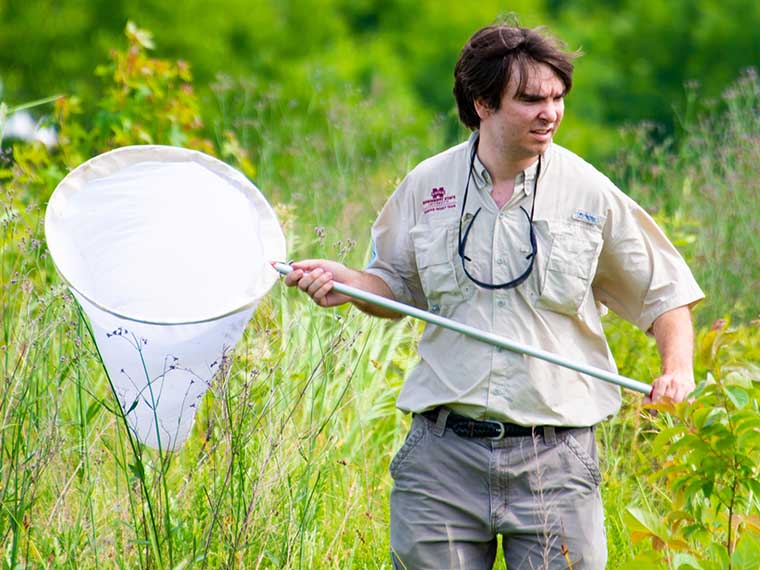The information presented on this page may be dated. It may refer to situations which have changed or people who are no longer affiliated with the university. It is archived as part of Mississippi State University's history.
Butterflies, albeit to a lesser degree, also serve as pollinators just like their honeybee counterparts. While there are nearly 600 species of butterflies commonly found in the U.S., MAFES researchers hope to better quantify butterflies in our own backyard-specifically those species located in the Sam D. Hamilton Noxubee National Wildlife Refuge.
Jordan Gesell, entomology master's student and laboratory technician in the Department of Biochemistry, Molecular Biology, Entomology, and Plant Pathology, is in the process of inventorying the refuge's butterflies.
"The biologists at the refuge have been wanting a butterfly survey conducted for a long time. They want to know what butterfly species are at the refuge and what habitats are supporting which butterfly species," said Dr. JoVonn Hill, MAFES scientist and Gesell's major professor.
Gesell is assessing the diversity and abundance of butterflies in the refuge over a period of three years, beginning in March 2018 through summer 2020.
Gesell considers butterflies, in general, as a highly captivating pollinator.
"The general public tends to find butterflies approachable and likable. Because of this, we can teach people about pollinators by showing them this beautiful, colorful, charismatic insect," he said.
Gesell uses two approaches to catalogue the different species.
"First, I visit interesting sites throughout the refuge, throughout the year, collect specimens, and take notes. The second aspect is a more standardized sampling regimen where I go out once a week and set out a series of transects, which are standardized paths 500 meters long that I walk at a standardized pace. I only tally butterflies that cross the transect as I'm walking," Gesell explained.
Gesell said butterflies are diurnal, so he collects data when they are known to be most active-between 10 a.m. and 2 p.m. on sunny days when the temperature is above 55 degrees.
"We sample through six habitat classes: pine, upland hardwood, bottomland hardwood, open fields, field edges, and then some moist soil units on the refuge the biologists wanted me to study closely. That's like an open field habitat. There are no trees, but the soils stay submerged for a certain part of the year. They suspect there will be different butterfly species attracted to those particular areas because of a variety of grasses and forbs that grow there," he said.
While tallying the butterflies, he also collects specimens from the various species, including a voucher specimen, which is housed at the museum and is used to validate that a particular species was, in fact, collected from the refuge. The voucher specimens will eventually be digitized into a global database. He'll also create a collection the refuge can display to teach visitors about the various butterflies that call the refuge home.
Gesell, a first-generation college graduate and Picayune native, has been interested in insects since elementary school and began seriously collecting specimens in high school. He started working for the Mississippi Entomological Museum as a student worker in 2013 and graduated with his bachelor's in interdisciplinary studies in 2015. He began his master's in 2017 and plans to graduate in May 2020.
"I've been collecting insects since the fourth grade but didn't know the proper way to do it until the latter part of high school and then I kept collecting through college," he said.
Thus far, he's recorded 55 species at the refuge.
"We want a baseline inventory of butterfly species throughout the area including what sort of habitats different species are most common in and a record of whatever plant associations we can observe," he explained.
He's also drilling down on several pine sites and studying them at different stages of management.
"The refuge manages pine stands for the red-cockaded woodpecker and many of these stands are in different stages of management. Some are overgrown and wild, while others are open pine savannas, which is the type of habitat the woodpeckers prefer.
Gesell said a large gradient exists between the two types of pine stands.
"I've selected pine sites at different points on that gradient to see if butterflies are more abundant in the pine stands managed for red-cockaded woodpeckers," he said. "This will help the refuge potentially manage for butterfly species as well.
For Gesell, the best part of the job is in the collecting.
"I have a drive for inventorying and classifying insects. I love being in the museum and doing the work to collect and preserve the specimens," he said.
We want a baseline inventory of butterfly species throughout the area including what sort of habitats different species are most common in and a record of whatever plant associations we can observe.
Jordan Gesell
Behind the Science

JoVonn Hill
Assistant Research Professor
Education: B.S., Interdisciplinary Science, M.S., Agriculture and Life Science, Ph.D., Agriculture and Life Science, Mississippi State University
Years At MSU: 13
Focus: Biodiversity of the southeastern United States
Passion At Work: Myself and my team focus on documenting and understanding the biodiversity in the southeastern United States. We do this primarily by surveying for native and exotic insect species and investigating the effects of land management practices on rare species or ecosystems in the region.

